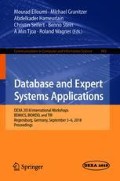Abstract
Machine Learning is one of the top growing fields of recent times and is applied in various areas such as healthcare. In this article, machine learning is used to study the patients suffering from either gout or leukemia, but not both, with the use of their uric acid signatures. The study of the uric acid signatures involves the application of supervised machine learning, using an artificial neural network (ANN) with one hidden layer and sigmoid activation function, to classify patients and the calculation of the accuracy with k-fold cross validation. We identify the number of nodes in the hidden layer and a value for the weight decay parameter that are optimal in terms of accuracy and ensure good performance.
Access this chapter
Tax calculation will be finalised at checkout
Purchases are for personal use only
Notes
- 1.
In R, duplicated function with logical negation operator (!) is used to find unique SUBJECT_IDs.
References
Alvarez-Lario, B., MacArron-Vicente, J.: Is there anything good in uric acid? QJM: Int. J. Med. 104, 1015–1024 (2011)
Celli, F., Cumbo, F., Weitschek, E.: Classification of large DNA methylation datasets for identifying cancer drivers. Big Data Res. (2018). https://www.sciencedirect.com/science/article/pii/S2214579617302708?via%3Dihub
Changhau, I.: Weight Initialization in Artificial Neural Networks (2017). https://isaacchanghau.github.io/2017/05/24/Weight-Initialization-in-Artificial-Neural-Networks/
Eaton, J.W., Bateman, D., Hauberg, S., Wehbring, R.: GNU Octave version 4.2.0 manual: a high-level interactive language for numerical computations (2016). http://www.gnu.org/software/octave/doc/interpreter
Goldberger, A.L., et al.: PhysioBank, PhysioToolkit, and PhysioNet: components of a new research resource for complex physiologic signals. Circ. Electron. 101, e215–e220 (2000)
Johnson, A.E., et al.: MIMIC-III, a freely accessible critical care database. Sci. Data 24, 1600355 (2016)
Kotsiantis, S.B.: Supervised machine learning: a review of classification techniques. In: Maglogiannis, I.G., Karpouzis, K., Wallace, M. (eds.) Emerging artificial intelligence applications in computer engineering: real word AI systems with applications in eHealth, HCI, Information Retrieval and Pervasive Technologies, pp. 3–24. IOS Press (2007)
Kourou, K., Exarchos, T.P., Exarchos, K.P., Karamouzis, M.V., Fotiadis, D.I.: Machine learning applications in cancer prognosis and prediction. Comput. Struct. Biotechnol. J. 13, 8–17 (2015)
Lasko, T.A., Denny, J.C., Levy, M.A.: Computational phenotype discovery using unsupervised feature learning over noisy, sparse, and irregular clinical data. PLOS ONE 8(8) (2013). http://journals.plos.org/plosone/article?id=10.1371/journal.pone.0066341
Ng, A., Ngiam, J., Foo, C.Y., Mai, Y., Suen, C.: UFLDL Tutorial (2013). http://deeplearning.stanford.edu/wiki/index.php/UFLDL_Tutorial
Nguyen, D., Widrow, B.: Improving the learning speed of 2-layer neural networks by choosing initial values of the adaptive weights. In: IJCNN International Joint Conference on Neural Networks, vol. 3 (1990)
Nielsen, M.A.: Neural Networks and Deep Learning. Determination Press (2015). http://neuralnetworksanddeeplearning.com/
Roden, D.M., et al.: Development of a large-scale de-identified DNA biobank to enable personalized medicine. Clin. Pharmacol. Ther. 84, 362–369 (2008)
Schmidt, M.: minFunc: unconstrained differentiable multivariate optimization in Matlab (2005). https://www.cs.ubc.ca/~schmidtm/Software/minFunc.html
Team, R.C.: R: A Language and Environment for Statistical Computing. R Foundation for Statistical Computing, Vienna (2014). https://www.r-project.org/
Weng, S.F., Reps, J., Kai, J., Garibaldi, J.M., Qureshi, N.: Can machine-learning improve cardiovascular risk prediction using routine clinical data? PLoS ONE 12(4), 1–14 (2017)
Wilcox, W.: Abnormal serum uric acid levels in children. J. Pediatr. 128, 731741 (1996)
Author information
Authors and Affiliations
Corresponding author
Editor information
Editors and Affiliations
Rights and permissions
Copyright information
© 2018 Springer Nature Switzerland AG
About this paper
Cite this paper
Bahra, G., Wiese, L. (2018). Classifying Leukemia and Gout Patients with Neural Networks. In: Elloumi, M., et al. Database and Expert Systems Applications. DEXA 2018. Communications in Computer and Information Science, vol 903. Springer, Cham. https://doi.org/10.1007/978-3-319-99133-7_12
Download citation
DOI: https://doi.org/10.1007/978-3-319-99133-7_12
Published:
Publisher Name: Springer, Cham
Print ISBN: 978-3-319-99132-0
Online ISBN: 978-3-319-99133-7
eBook Packages: Computer ScienceComputer Science (R0)

